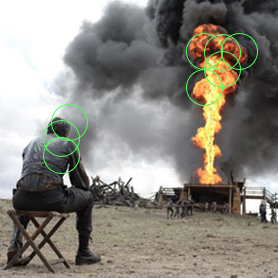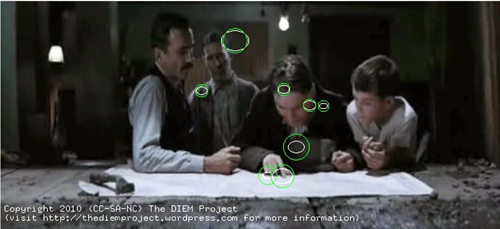 Of late, I’ve become increasingly fascinated by the psychological and optic processes the human body goes through while viewing movies- an interest that was largely sparked by research into viewing stereoscopic images for my piece about the state of 3D films*. It’s a topic that fascinates most people I think, at least when they happen to run across a particularly interesting look into it. The increased sophistication of the research into the subject has certainly given birth to some cool technology, including devices that can track eye movement with great precision. The tech isn’t new necessarily- it has already been integrated into consumer picture cameras that track where in the frame you are looking and auto-focus the lens accordingly. Now psychological researcher Tim Smith of Continuity Boy has applied that technology to viewers watching a motion picture –a scene from There Will Be Blood specifically– and come up with some unsurprising but endlessly fascinating conclusions. This is definitely one of those aforementioned “particularly interesting” looks into the physical means by which we watch films.
Of late, I’ve become increasingly fascinated by the psychological and optic processes the human body goes through while viewing movies- an interest that was largely sparked by research into viewing stereoscopic images for my piece about the state of 3D films*. It’s a topic that fascinates most people I think, at least when they happen to run across a particularly interesting look into it. The increased sophistication of the research into the subject has certainly given birth to some cool technology, including devices that can track eye movement with great precision. The tech isn’t new necessarily- it has already been integrated into consumer picture cameras that track where in the frame you are looking and auto-focus the lens accordingly. Now psychological researcher Tim Smith of Continuity Boy has applied that technology to viewers watching a motion picture –a scene from There Will Be Blood specifically– and come up with some unsurprising but endlessly fascinating conclusions. This is definitely one of those aforementioned “particularly interesting” looks into the physical means by which we watch films.
Tim’s process was simple- he tracked the gazes of 11 people while watching a six minute scene from There Will Be Blood. The scene is notable for its extremely minimal camera movement, and highly restrained picture editing. Paul Thomas Anderson and cinematographer Robert Elswit’s deliberately chose staging, light, and reliance on physical cues from the actors to guide audience attention through the scene and through the frames. The use of these techniques means this is an excellent scene for testing how humans register and explore motion-picture images. Smith’s conclusions are collected in a guest blog hosted by David Bordwell’s website on cinema, and includes over a dozen videos and examined stills. The first was an overlay of the the individual viewing results that represented each viewers gaze with circles that grew proportionally to how long attention was held on a specific point. The result is a sporadic collection of vibrating points that still manage to show how most viewers find the same places to look within each frame, and that these points of interest follow the rhythm of the scene between the actors, with strong reactions to newly introduced points of light and motion.

While that’s fascinating in and of itself, the “peekthrough heatmap” Smith generated based on these points is a very cool version of the video that is coated in an opaque layer of black that becomes transparent only at the points where the viewers were focusing their attention. This is a very interesting way of watching the scene, and it demonstrates just how obscenely well-constructed PTA and Elswit’s images truly are.
I would suggest you take a look at the video (there are more in the original) and go read the blog- it’s extremely fascinating stuff.
(thanks to Ebert for bring my attention to this.)
DISCUSS THIS on the CHUD Message Board
&
Like / Share it on Facebook (above or below) if you think it’s great!
*And there was a lot of research- hence the shameless and repeated pimping of said article.